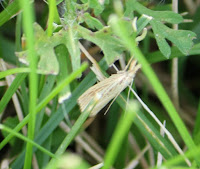"What worries me more is that most Americans know little of — and care even less about — the spectacular natural diversity surrounding every one of us. We are ignorant of the rainbow of warblers — dozens of species — passing through in migration each spring. We overlook the orchids growing in roadside ditches. Most of us cannot identify what’s singing or croaking or buzzing in our own backyards....
If we do not know what lives next to us, we will not notice when it’s gone."
Bryan Pfeiffer, The Extinction of Meaning
The Sycamore Greenway, like many other trails and natural areas, is a haven for wildlife. It doesn't require a lot of upkeep (though it could certainly benefit from some thinning of trees growing in the northern basins, and some wild parsnip mitigation in the south), just some native grasses and forbs and a bit of space.
The Greenway gives us access to so many small lives that we otherwise wouldn't see. I can plant my entire yard with native flowers and enjoy the bees, butterflies and other insects that come...but they are stuck on an island amid acres of barren turfgrass, some of it laced with poisons from neighbors less tolerant of functioning ecosystems on their property.
The Greenway, on the other hand, offers dozens of acres of mostly unbroken habitat, where common suburban species mingle with slightly less common neighbors. This blog, and the related Facebook page, were meant to introduce people to these neighbors and hopefully inspire, if not the wonder and awe of magnificent endangered megafauna, at least affection for these tiny inhabitants of our own local natural areas.
Without the Greenway, would I have encountered this odd little Physocephala fly, with its flared antennae, waspy waist and two-toned wings? Who knew there were so many different kinds of flies in our area? Obviously, the abundance and vast variety of insects is no secret, but it becomes so much more meaningful when you meet some of these little guys in person.
And these are just the obvious individuals who politely hang out in highly-visible areas on flowers and leaves--imagine getting down in the weeds and grass, how many more different flies would we find--let alone grasshoppers, wasps, bees, ants, beetles, and hundreds of other insects (not to mention all their larvae), all sharing the same space and playing their own small, essential role in it.
Would we miss this Physocephala fly if it were to disappear? Or any one of the hundreds of species out in our backyards? Probably not. But that doesn't make them any less worthy of getting to know.




















